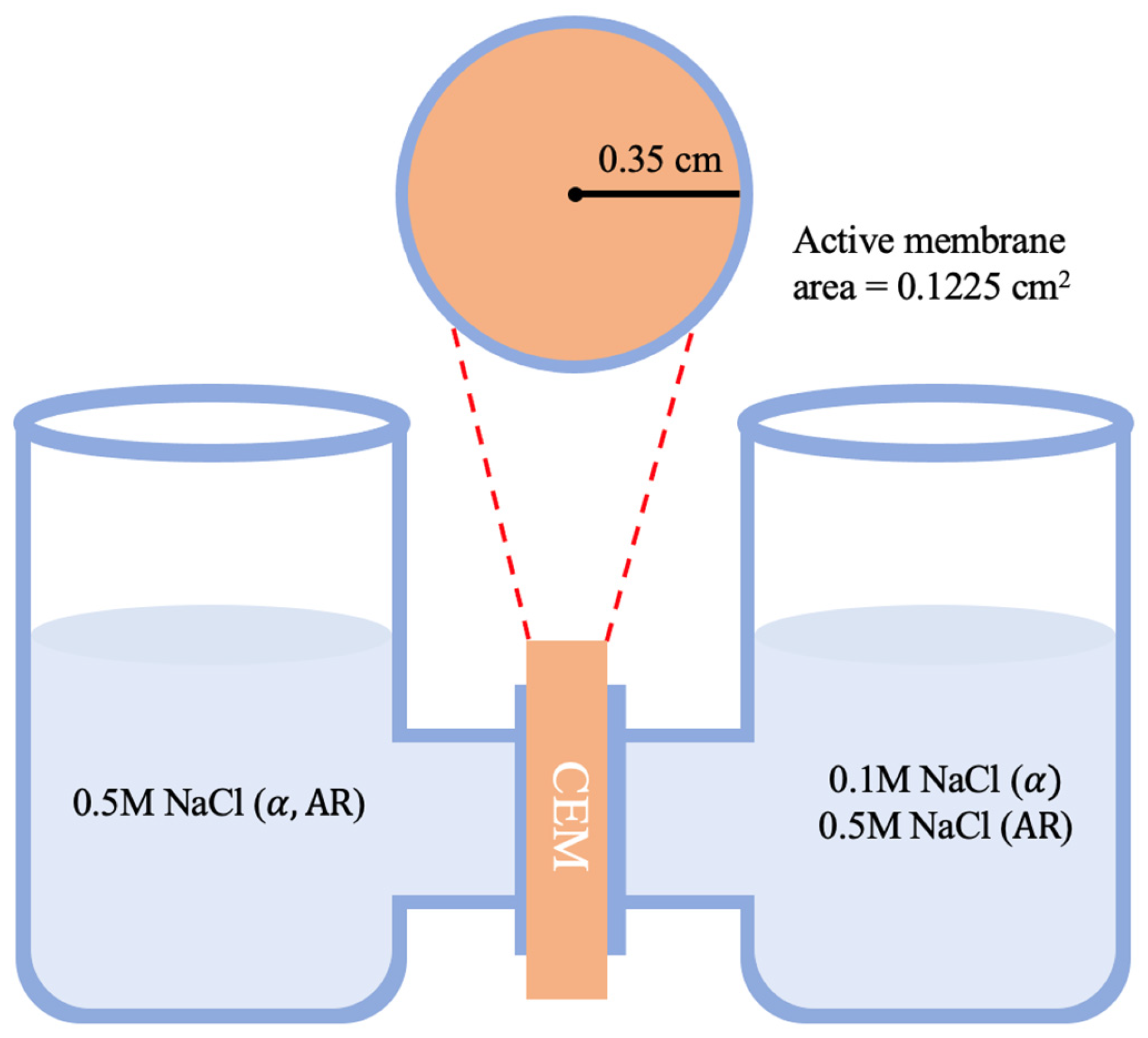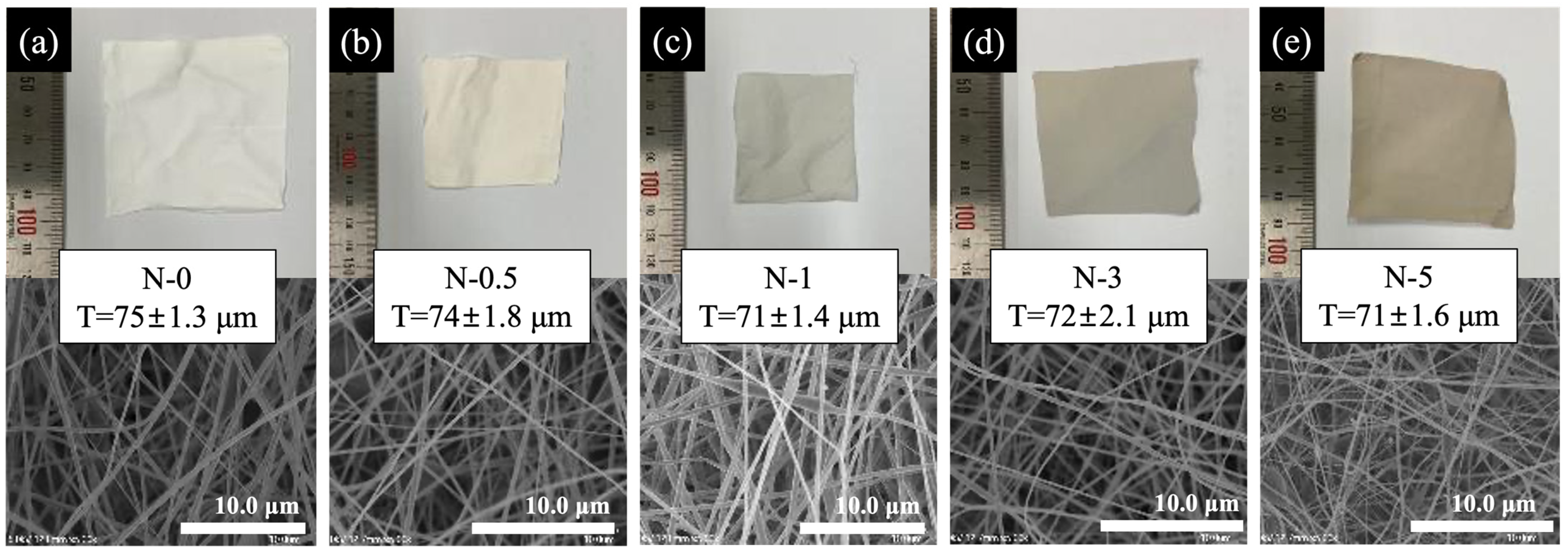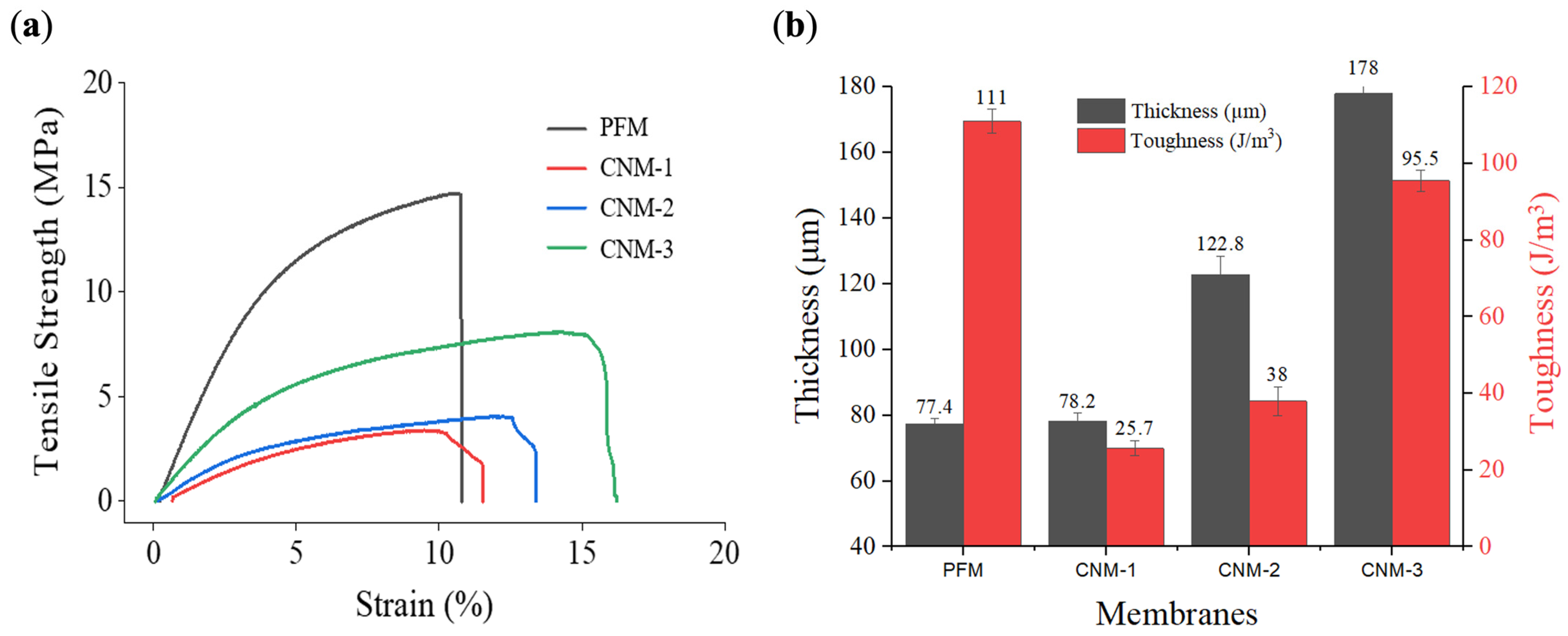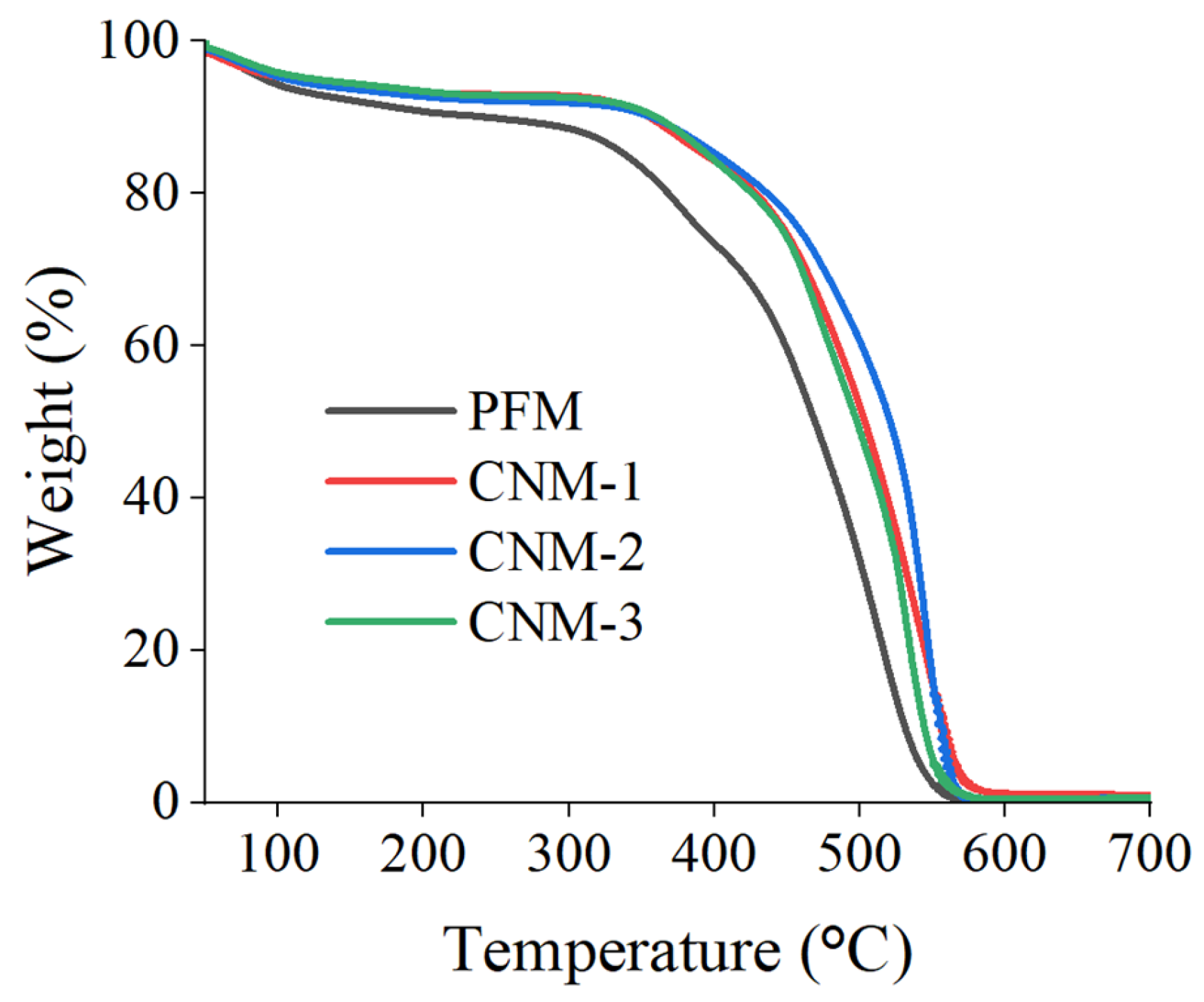Fabrication and Performance Evaluation of a Cation Exchange Membrane Using Graphene Oxide/Polyethersulfone Composite Nanofibers
Abstract
:1. Introduction
2. Materials and Methods
2.1. Materials
2.2. Nanofiber Preparation
2.3. Pore-Filling
2.4. Characterization
3. Results
3.1. Effect of GO on the Electrospun PES Nanofiber
3.2. Effects of the Pore-Filled Structure Design on Membrane Performance
4. Conclusions
Author Contributions
Funding
Institutional Review Board Statement
Data Availability Statement
Conflicts of Interest
References
- Tian, M.; Wang, R.; Goh, K.; Liao, Y.; Fane, A.G. Synthesis and Characterization of High-Performance Novel Thin Film Nanocomposite PRO Membranes with Tiered Nanofiber Support Reinforced by Functionalized Carbon Nanotubes. J. Membr. Sci. 2015, 486, 151–160. [Google Scholar] [CrossRef]
- Hickenbottom, K.L.; Vanneste, J.; Elimelech, M.; Cath, T.Y. Assessing the Current State of Commercially Available Membranes and Spacers for Energy Production with Pressure Retarded Osmosis. Desalination 2016, 389, 108–118. [Google Scholar] [CrossRef] [Green Version]
- ESCAP U.N. Water Security & the Global Water Agenda: A UN-Water Analytical Brief; United Nations University (UNU): Tokyo, Japan, 2013; ISBN 9280860380. [Google Scholar]
- Griffiths, J.; Lambert, R. Free Flow: Reaching Water Security through Cooperation; UNESCO: London, UK, 2013; ISBN 9231042564. [Google Scholar]
- Gerlak, A.K.; House-Peters, L.; Varady, R.G.; Albrecht, T.; Zúñiga-Terán, A.; de Grenade, R.R.; Cook, C.; Scott, C.A. Water Security: A Review of Place-Based Research. Environ. Sci. Policy 2018, 82, 79–89. [Google Scholar] [CrossRef]
- Campione, A.; Gurreri, L.; Ciofalo, M.; Micale, G.; Tamburini, A.; Cipollina, A. Electrodialysis for Water Desalination: A Critical Assessment of Recent Developments on Process Fundamentals, Models and Applications. Desalination 2018, 434, 121–160. [Google Scholar] [CrossRef]
- Oren, Y. Capacitive Deionization (CDI) for Desalination and Water Treatment—Past, Present and Future (a Review). Desalination 2008, 228, 10–29. [Google Scholar] [CrossRef]
- AlMarzooqi, F.A.; Al Ghaferi, A.A.; Saadat, I.; Hilal, N. Application of Capacitive Deionisation in Water Desalination: A Review. Desalination 2014, 342, 3–15. [Google Scholar] [CrossRef]
- Al-Amshawee, S.; Yunus, M.Y.B.M.; Azoddein, A.A.M.; Hassell, D.G.; Dakhil, I.H.; Hasan, H.A. Electrodialysis Desalination for Water and Wastewater: A Review. Chem. Eng. J. 2020, 380, 122231. [Google Scholar] [CrossRef]
- Park, S.G.; Rajesh, P.P.; Hwang, M.H.; Chu, K.H.; Cho, S.; Chae, K.J. Long-Term Effects of Anti-Biofouling Proton Exchange Membrane Using Silver Nanoparticles and Polydopamine on the Performance of Microbial Electrolysis Cells. Int. J. Hydrogen Energy 2021, 46, 11345–11356. [Google Scholar] [CrossRef]
- Geise, G.M.; Hickner, M.A.; Logan, B.E. Ionic Resistance and Permselectivity Tradeoffs in Anion Exchange Membranes. ACS Appl. Mater. Interfaces 2013, 5, 10294–10301. [Google Scholar] [CrossRef]
- Kim, T.N.; Lee, J.; Choi, J.H.; Ahn, J.H.; Yang, E.; Hwang, M.H.; Chae, K.J. Tunable Atomic Level Surface Functionalization of a Multi-Layered Graphene Oxide Membrane to Break the Permeability-Selectivity Trade-off in Salt Removal of Brackish Water. Sep. Purif. Technol. 2021, 274, 119047. [Google Scholar] [CrossRef]
- Kallem, P.; Yanar, N.; Choi, H. Nanofiber-Based Proton Exchange Membranes: Development of Aligned Electrospun Nanofibers for Polymer Electrolyte Fuel Cell Applications. ACS Sustain. Chem. Eng. 2019, 7, 1808–1825. [Google Scholar] [CrossRef]
- Siddique, T.; Dutta, N.K.; Choudhury, N.R. Mixed-Matrix Membrane Fabrication for Water Treatment. Membranes 2021, 11, 557. [Google Scholar] [CrossRef]
- Muntha, S.T.; Kausar, A.; Siddiq, M. A Review Featuring Fabrication, Properties, and Application of Polymeric Mixed Matrix Membrane Reinforced with Different Fillers. Polym. Plast. Technol. Eng. 2017, 56, 2043–2064. [Google Scholar] [CrossRef]
- Mulder, F.M.; Weninger, B.M.H.; Middelkoop, J.; Ooms, F.G.B.; Schreuders, H. Efficient Electricity Storage with a Battolyser, an Integrated Ni–Fe Battery and Electrolyser. Energy Environ. Sci. 2017, 10, 756–764. [Google Scholar] [CrossRef] [Green Version]
- Schalenbach, M.; Tjarks, G.; Carmo, M.; Lueke, W.; Mueller, M.; Stolten, D. Acidic or Alkaline? Towards a New Perspective on the Efficiency of Water Electrolysis. J. Electrochem. Soc. 2016, 163, F3197. [Google Scholar] [CrossRef] [Green Version]
- Długołęcki, P.; Nymeijer, K.; Metz, S.; Wessling, M. Current Status of Ion Exchange Membranes for Power Generation from Salinity Gradients. J. Membr. Sci. 2008, 319, 214–222. [Google Scholar] [CrossRef]
- Logan, B.E.; Elimelech, M. Membrane-Based Processes for Sustainable Power Generation Using Water. Nature 2012, 488, 313–319. [Google Scholar] [CrossRef]
- Khoiruddin; Aryanti, P.T.P.; Hakim, A.N.; Wenten, I.G. The Role of Ion-Exchange Membrane in Energy Conversion. AIP Conf. Proc. 2017, 1840, 090006. [Google Scholar] [CrossRef]
- Ran, J.; Wu, L.; He, Y.; Yang, Z.; Wang, Y.; Jiang, C.; Ge, L.; Bakangura, E.; Xu, T. Ion Exchange Membranes: New Developments and Applications. J. Membr. Sci. 2017, 522, 267–291. [Google Scholar] [CrossRef]
- Di Noto, V.; Vezzù, K.; Crivellaro, G.; Pagot, G.; Sun, C.; Meda, L.; Rutkowska, I.A.; Kulesza, P.J.; Zawodzinski, T.A. A General Electrochemical Formalism for Vanadium Redox Flow Batteries. Electrochim. Acta 2022, 408, 139937. [Google Scholar] [CrossRef]
- Zhang, H.; Sun, C.; Ge, M. Review of the Research Status of Cost-Effective Zinc–Iron Redox Flow Batteries. Batteries 2022, 8, 202. [Google Scholar] [CrossRef]
- Kim, B.; Yang, E.; Kim, B.; Obaid, M.; Jang, J.K.; Chae, K.J. Recent Application of Nanomaterials to Overcome Technological Challenges of Microbial Electrolysis Cells. Nanomaterials 2022, 12, 1316. [Google Scholar] [CrossRef]
- Yang, E.; Alayande, A.B.; Goh, K.; Kim, C.M.; Chu, K.H.; Hwang, M.H.; Ahn, J.H.; Chae, K.J. 2D Materials-Based Membranes for Hydrogen Purification: Current Status and Future Prospects. Int. J. Hydrogen Energy 2021, 46, 11389–11410. [Google Scholar] [CrossRef]
- Yin, J.; Deng, B. Polymer-Matrix Nanocomposite Membranes for Water Treatment. J. Membr. Sci. 2015, 479, 256–275. [Google Scholar] [CrossRef]
- Casado-Coterillo, C. Mixed Matrix Membranes. Membranes 2019, 9, 149. [Google Scholar] [CrossRef] [PubMed] [Green Version]
- Fahmi, M.Z.; Wathoniyyah, M.; Khasanah, M.; Rahardjo, Y.; Wafiroh, S.; Abdulloh. Incorporation of Graphene Oxide in Polyethersulfone Mixed Matrix Membranes to Enhance Hemodialysis Membrane Performance. RSC Adv. 2018, 8, 931–937. [Google Scholar] [CrossRef] [Green Version]
- Liu, Y.; Ma, H.; Hsiao, B.S.; Chu, B.; Tsou, A.H. Improvement of Meltdown Temperature of Lithium-Ion Battery Separator Using Electrospun Polyethersulfone Membranes. Polymer 2016, 107, 163–169. [Google Scholar] [CrossRef] [Green Version]
- Gahlot, S.; Sharma, P.P.; Gupta, H.; Kulshrestha, V.; Jha, P.K. Preparation of Graphene Oxide Nano-Composite Ion-Exchange Membranes for Desalination Application. RSC Adv. 2014, 4, 24662–24670. [Google Scholar] [CrossRef]
- Leong, Z.Y.; Lu, G.; Yang, H.Y. Three-Dimensional Graphene Oxide and Polyvinyl Alcohol Composites as Structured Activated Carbons for Capacitive Desalination. Desalination 2019, 451, 172–181. [Google Scholar] [CrossRef]
- Abdelkader, B.A.; Antar, M.A.; Laoui, T.; Khan, Z. Development of Graphene Oxide-Based Membrane as a Pretreatment for Thermal Seawater Desalination. Desalination 2019, 465, 13–24. [Google Scholar] [CrossRef]
- Giwa, A.; Hasan, S.W. Novel Polyethersulfone-Functionalized Graphene Oxide (PES-FGO) Mixed Matrix Membranes for Wastewater Treatment. Sep. Purif. Technol. 2020, 241, 116735. [Google Scholar] [CrossRef]
- Movil, O.; Soc, J.E.; Movil, O.; Frank, L.; Staser, J.A. Graphene Oxide—Polymer Nanocomposite Anion-Exchange Membranes. J. Electrochem. Soc. 2015, 162, F419–F426. [Google Scholar] [CrossRef]
- Theophile, N.; Jeong, H.K. Electrochemical Properties of Poly (Vinyl Alcohol) and Graphene Oxide Composite for Supercapacitor Applications. Chem. Phys. Lett. 2017, 669, 125–129. [Google Scholar] [CrossRef]
- Karim, M.R.; Hatakeyama, K.; Matsui, T.; Takehira, H.; Taniguchi, T.; Koinuma, M.; Matsumoto, Y.; Akutagawa, T.; Nakamura, T.; Noro, S.; et al. Graphene Oxide Nanosheet with High Proton Conductivity. J. Am. Chem. Soc. 2013, 135, 8097–8100. [Google Scholar] [CrossRef]
- Kim, Y.; Ketpang, K.; Jaritphun, S.; Park, J.S.; Shanmugam, S. A Polyoxometalate Coupled Graphene Oxide–Nafion Composite Membrane for Fuel Cells Operating at Low Relative Humidity. J. Mater. Chem. A Mater. 2015, 3, 8148–8155. [Google Scholar] [CrossRef] [Green Version]
- Oh, K.; Son, B.; Sanetuntikul, J.; Shanmugam, S. Polyoxometalate Decorated Graphene Oxide/Sulfonated Poly(Arylene Ether Ketone) Block Copolymer Composite Membrane for Proton Exchange Membrane Fuel Cell Operating under Low Relative Humidity. J. Membr. Sci. 2017, 541, 386–392. [Google Scholar] [CrossRef]
- Zhang, C.L.; Yu, S.H. Nanoparticles Meet Electrospinning: Recent Advances and Future Prospects. Chem. Soc. Rev. 2014, 43, 4423–4448. [Google Scholar] [CrossRef]
- Greiner, A.; Wendorff, J.H. Electrospinning: A Fascinating Method for the Preparation of Ultrathin Fibers. Angew. Chem.-Int. Ed. 2007, 46, 5670–5703. [Google Scholar] [CrossRef]
- Zhang, W.; He, Z.; Han, Y.; Jiang, Q.; Zhan, C.; Zhang, K.; Li, Z.; Zhang, R. Structural Design and Environmental Applications of Electrospun Nanofibers. Compos. Part A Appl. Sci. Manuf. 2020, 137, 106009. [Google Scholar] [CrossRef]
- Ma, X.H.; Yang, Z.; Yao, Z.K.; Guo, H.; Xu, Z.L.; Tang, C.Y. Interfacial Polymerization with Electrosprayed Microdroplets: Toward Controllable and Ultrathin Polyamide Membranes. Environ. Sci. Technol. Lett. 2018, 5, 117–122. [Google Scholar] [CrossRef]
- Barakat, N.A.M.; Kanjwal, M.A.; Sheikh, F.A.; Kim, H.Y. Spider-Net within the N6, PVA and PU Electrospun Nanofiber Mats Using Salt Addition: Novel Strategy in the Electrospinning Process. Polymer 2009, 50, 4389–4396. [Google Scholar] [CrossRef]
- Ahmed, F.E.; Lalia, B.S.; Hashaikeh, R. A Review on Electrospinning for Membrane Fabrication: Challenges and Applications. Desalination 2015, 356, 15–30. [Google Scholar] [CrossRef]
- Jung, J.T.; Kim, J.F.; Wang, H.H.; di Nicolo, E.; Drioli, E.; Lee, Y.M. Understanding the Non-Solvent Induced Phase Separation (NIPS) Effect during the Fabrication of Microporous PVDF Membranes via Thermally Induced Phase Separation (TIPS). J. Membr. Sci. 2016, 514, 250–263. [Google Scholar] [CrossRef]
- Wang, H.; Ding, S.; Zhu, H.; Wang, F.; Guo, Y.; Zhang, H.; Chen, J. Effect of Stretching Ratio and Heating Temperature on Structure and Performance of PTFE Hollow Fiber Membrane in VMD for RO Brine. Sep. Purif. Technol. 2014, 126, 82–94. [Google Scholar] [CrossRef]
- Hartgerink, J.D.; Beniash, E.; Stupp, S.I. Self-Assembly and Mineralization of Peptide-Amphiphile Nanofibers. Science 2001, 294, 1684–1688. [Google Scholar] [CrossRef] [Green Version]
- Odularu, A.T. Basic Principles of Electrospinning, Mechanisms, Nanofibre Production, and Anticancer Drug Delivery. J. Chem. 2022, 2022, 9283325. [Google Scholar] [CrossRef]
- Sinha-Ray, S.; Zhang, W.; Sahu, R.P.; Sinha-Ray, S.; Yarin, A.L. Pool Boiling of Novec 7300 and DI Water on Nano-Textured Heater Covered with Supersonically-Blown or Electrospun Polymer Nanofibers. Int. J. Heat Mass Transf. 2017, 106, 482–490. [Google Scholar] [CrossRef]
- Hassan, M.A.; Yeom, B.Y.; Wilkie, A.; Pourdeyhimi, B.; Khan, S.A. Fabrication of Nanofiber Meltblown Membranes and Their Filtration Properties. J. Membr. Sci. 2013, 427, 336–344. [Google Scholar] [CrossRef]
- Duraikkannu, S.L.; Castro-Muñoz, R.; Figoli, A. A Review on Phase-Inversion Technique-Based Polymer Microsphere Fabrication. Colloid Interface Sci. Commun. 2021, 40, 100329. [Google Scholar] [CrossRef]
- Kumar, V.V.; Balaganesan, G.; Lee, J.K.Y.; Neisiany, R.E.; Surendran, S.; Ramakrishna, S. A Review of Recent Advances in Nanoengineered Polymer Composites. Polymers 2019, 11, 644. [Google Scholar] [CrossRef] [Green Version]
- Chae, K.-J.; Kim, K.-Y.; Choi, M.-J.; Yang, E.; Kim, I.S.; Ren, X.; Lee, M. Sulfonated Polyether Ether Ketone (SPEEK)-Based Composite Proton Exchange Membrane Reinforced with Nanofibers for Microbial Electrolysis Cells. Chem. Eng. J. 2014, 254, 393–398. [Google Scholar] [CrossRef]
- Ramya, K.; Velayutham, G.; Subramaniam, C.K.; Rajalakshmi, N.; Dhathathreyan, K.S. Effect of Solvents on the Characteristics of Nafion®/PTFE Composite Membranes for Fuel Cell Applications. J. Power Sources 2006, 160, 10–17. [Google Scholar] [CrossRef]
- Rodgers, M.P.; Berring, J.; Holdcroft, S.; Shi, Z. The Effect of Spatial Confinement of Nafion® in Porous Membranes on Macroscopic Properties of the Membrane. J. Membr. Sci. 2008, 321, 100–113. [Google Scholar] [CrossRef]
- Kim, K.; Kim, S.-K.; Park, J.O.; Choi, S.-W.; Kim, K.-H.; Ko, T.; Pak, C.; Lee, J.-C. Highly Reinforced Pore-Filling Membranes Based on Sulfonated Poly(Arylene Ether Sulfone)s for High-Temperature/Low-Humidity Polymer Electrolyte Membrane Fuel Cells. J. Membr. Sci. 2017, 537, 11–21. [Google Scholar] [CrossRef]
- Gloukhovski, R.; Freger, V.; Tsur, Y. Understanding Methods of Preparation and Characterization of Pore-Filling Polymer Composites for Proton Exchange Membranes: A Beginner’s Guide. Rev. Chem. Eng. 2018, 34, 455–479. [Google Scholar] [CrossRef]
- Jang, J.; Park, I.; Chee, S.S.; Song, J.H.; Kang, Y.; Lee, C.; Lee, W.; Ham, M.H.; Kim, I.S. Graphene Oxide Nanocomposite Membrane Cooperatively Cross-Linked by Monomer and Polymer Overcoming the Trade-off between Flux and Rejection in Forward Osmosis. J. Membr. Sci. 2019, 470, 117684. [Google Scholar] [CrossRef]
- Kang, Y.; Obaid, M.; Jang, J.; Kim, I.S. Sulfonated Graphene Oxide Incorporated Thin Film Nanocomposite Nanofiltration Membrane to Enhance Permeation and Antifouling Properties. Desalination 2019, 470, 114125. [Google Scholar] [CrossRef]
- Kang, Y.; Obaid, M.; Jang, J.; Ham, M.H.; Kim, I.S. Novel Sulfonated Graphene Oxide Incorporated Polysulfone Nanocomposite Membranes for Enhanced-Performance in Ultrafiltration Process. Chemosphere 2018, 207, 581–589. [Google Scholar] [CrossRef]
- Rag, S.A.; Selvakumar, M.; Bhat, S.; Chidangil, S.; De, S. Synthesis and Characterization of Reduced Graphene Oxide for Supercapacitor Application with a Biodegradable Electrolyte. J. Electron. Mater. 2020, 49, 985–994. [Google Scholar] [CrossRef]
- Chen, H.; Elabd, Y.A. Polymerized Ionic Liquids: Solution Properties and Electrospinning. Macromolecules 2009, 42, 3368–3373. [Google Scholar] [CrossRef]
- Jang, J.; Kang, Y.; Kim, K.; Kim, S.; Son, M.; Chee, S.S.; Kim, I.S. Concrete-Structured Nafion@MXene/Cellulose Acetate Cation Exchange Membrane for Reverse Electrodialysis. J. Membr. Sci. 2022, 646, 120239. [Google Scholar] [CrossRef]
- Hollaway, L.C. High Performance Fibre-Reinforced Composites for Sustainable Energy Applications. In High Performance Textiles and Their Applications; Lawrence, C.A., Ed.; Woodhead Publishing Series in Textiles; Woodhead Publishing: Amsterdam, The Netherlands, 2014; pp. 366–417. ISBN 9780857099075. [Google Scholar]
- Kuila, T.; Mishra, A.K.; Khanra, P.; Kim, N.H.; Lee, J.H. Recent Advances in the Efficient Reduction of Graphene Oxide and Its Application as Energy Storage Electrode Materials. Nanoscale 2013, 5, 52–71. [Google Scholar] [CrossRef] [PubMed]
- Li, J.; Liu, D.; Li, B.; Wang, J.; Han, S.; Liu, L.; Wei, H. A Bio-Inspired Nacre-like Layered Hybrid Structure of Calcium Carbonate under the Control of Carboxyl Graphene. CrystEngComm 2015, 17, 520–525. [Google Scholar] [CrossRef]
- Ahmad, M.S.; Mohshim, D.F.; Nasir, R.; Mannan, H.A.; Mukhtar, H. Effect of Solvents on the Morphology and Performance of Polyethersulfone (PES) Polymeric Membranes Material for CO2/CH4 Separation. IOP Conf. Ser. Mater. Sci. Eng. 2018, 290, 012074. [Google Scholar] [CrossRef]
- Mollá, S.; Compañ, V. Polyvinyl Alcohol Nanofiber Reinforced Nafion Membranes for Fuel Cell Applications. J. Membr. Sci. 2011, 372, 191–200. [Google Scholar] [CrossRef]
- Salinas-Rodriguez, S.G.; Amy, G.L.; Schippers, J.C.; Kennedy, M.D. The Modified Fouling Index Ultrafiltration Constant Flux for Assessing Particulate/Colloidal Fouling of RO Systems. Desalination 2015, 365, 79–91. [Google Scholar] [CrossRef] [Green Version]
- Konkena, B.; Vasudevan, S. Understanding Aqueous Dispersibility of Graphene Oxide and Reduced Graphene Oxide through PKa Measurements. J. Phys. Chem. Lett. 2012, 3, 867–872. [Google Scholar] [CrossRef]
- Alipour Moghaddam, J.; Parnian, M.J.; Rowshanzamir, S. Preparation, Characterization, and Electrochemical Properties Investigation of Recycled Proton Exchange Membrane for Fuel Cell Applications. Energy 2018, 161, 699–709. [Google Scholar] [CrossRef]









| Nanofiber | Fiber Diameter (nm) | Porosity (%) | Pore Size (µm) | Thickness (µm) | Toughness (J/m3) | WCA (°) |
|---|---|---|---|---|---|---|
| N-0 | 359 | 62.56 | 383.24 + 17.94 | 75.3 | 4.12 | 77.09 |
| N-0.5 | 306 | 64.10 | 347.52 + 24.48 | 74.8 | 17.51 | 67.72 |
| N-1 | 368 | 69.02 | 345.73 + 14.91 | 71.4 | 39.90 | 66.05 |
| N-3 | 365 | 66.51 | 372.1 + 28.14 | 72.1 | 20.04 | 63.60 |
| N-5 | 298 | 64.62 | 35.6 + 15.04 | 71.6 | 5.62 | 63.41 |
| Membrane | Thickness (μm) | Zeta Potential (mV) | WCA (°) | WU (%) | Permselectivity (%) | IEC (meq/gdry) | AR (Ω cm2) |
|---|---|---|---|---|---|---|---|
| PFM | 77.4 | −34.4 | 62.2 | 22.7 | 85.75 | 0.85 | 3.7 |
| CNM-1 | 78.2 | −31.7 | 68.2 | 20.3 | 75.99 | 0.91 | 14.7 |
| CNM-2 | 122.8 | −32.1 | 67.2 | 30.3 | 84.7 | 0.93 | 16.5 |
| CNM-3 | 178.0 | −31.4 | 69.2 | 33.9 | 92.88 | 0.96 | 20.1 |
Disclaimer/Publisher’s Note: The statements, opinions and data contained in all publications are solely those of the individual author(s) and contributor(s) and not of MDPI and/or the editor(s). MDPI and/or the editor(s) disclaim responsibility for any injury to people or property resulting from any ideas, methods, instructions or products referred to in the content. |
© 2023 by the authors. Licensee MDPI, Basel, Switzerland. This article is an open access article distributed under the terms and conditions of the Creative Commons Attribution (CC BY) license (https://creativecommons.org/licenses/by/4.0/).
Share and Cite
Kim, S.; Alayande, A.B.; Eisa, T.; Jang, J.; Kang, Y.; Yang, E.; Hwang, M.-H.; Kim, I.S.; Chae, K.-J. Fabrication and Performance Evaluation of a Cation Exchange Membrane Using Graphene Oxide/Polyethersulfone Composite Nanofibers. Membranes 2023, 13, 633. https://doi.org/10.3390/membranes13070633
Kim S, Alayande AB, Eisa T, Jang J, Kang Y, Yang E, Hwang M-H, Kim IS, Chae K-J. Fabrication and Performance Evaluation of a Cation Exchange Membrane Using Graphene Oxide/Polyethersulfone Composite Nanofibers. Membranes. 2023; 13(7):633. https://doi.org/10.3390/membranes13070633
Chicago/Turabian StyleKim, Suhun, Abayomi Babatunde Alayande, Tasnim Eisa, Jaewon Jang, Yesol Kang, Euntae Yang, Moon-Hyun Hwang, In S. Kim, and Kyu-Jung Chae. 2023. "Fabrication and Performance Evaluation of a Cation Exchange Membrane Using Graphene Oxide/Polyethersulfone Composite Nanofibers" Membranes 13, no. 7: 633. https://doi.org/10.3390/membranes13070633






